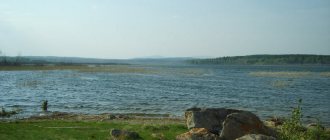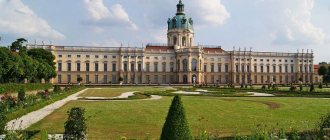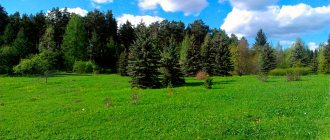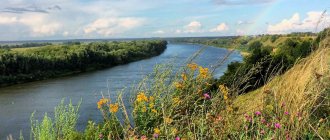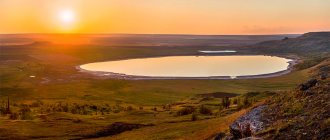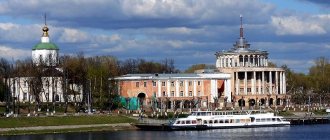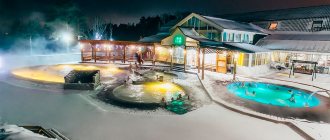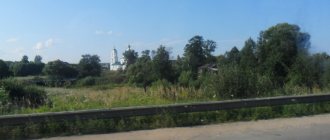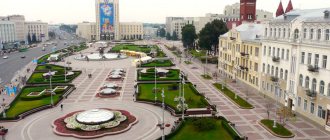Lake Chebarkul, located in the Chebarkul district of the Chelyabinsk region, became known to the whole world after the event that occurred on February 15, 2013. On this day, a meteorite fell into the reservoir, which was later named Chelyabinsk.
Dimensions of the reservoir: length - almost 6 kilometers, width - 5.1 kilometers. The average depth of the reservoir is 6 meters, the maximum can reach 12 meters.
© Ruslan Garipov
Chebarkul Church of the Transfiguration of the Lord
On the site of the old destroyed church of the 19th century, a new Church of the Transfiguration of the Lord appeared. It is located in the western part of the city on Pushkin Street, 24.
The history of the old Chebarkul church is connected with the uprising of Emelyan Pugachev. It burned down in 1775 after Pugachev’s retreat. In 2007, a new creation appeared on this site, which retained the style of its predecessor.
The Church of the Transfiguration of the Lord is a temple with five domes and six pillars with porches. There is also a high bell tower, which looks like an open gallery from the inside.
Lower Church of the Transfiguration of the Lord
One of the most beautiful temples is the Lower Church of the Transfiguration of the Lord. Construction of the temple took about three years. It is also known that about 55 million rubles were spent on the construction of the temple. Moreover, most of the amount was donated by parishioners.
The temple began its existence back in 1475. It was built during the founding of the Chebarkul fortress.
On every Christian holiday, the church is consecrated here. Consecration is one of the greatest events in scripture.
Temple in honor of the Holy Martyr John the Warrior
Currently, this temple is located in a railway carriage. On the trailer there is an onion with a cross. Not far from the trailer there is a banner depicting a church in the future. This temple began its existence in 2007. Today the temple is equipped with an iconostasis and icons are hung.
Location: 40 Let Pobedy street - 31B/3.
Historical and cultural regional museum named after Gerasimov
This museum is dedicated to one of the most outstanding film directors Sergei Apollinarievich Gerasimov . The museum is directly connected with the life of the talented director. In the museum you can see what the furnishings of Gerasimov’s office looked like, as well as his library, certificates of honor and diplomas.
Many tourists come to see the same Gerasimov cane that was given to him by Charlie Chaplin himself. They were very close friends.
There is also a small corner in the museum that is dedicated to Makarova. T.F., the director’s wife. Many of her awards and some personal items are here.
How to get there
You can get to the city of Chebarkul by personal or rented car, by public transport or taxi.
Bus
Every day from Chelyabinsk to Chebarkul from the Central bus station there are buses No. 501,506/2,552, 596, 946, 503/2, 503/4, 551, 517/1, 804/2, 519/1, 532, 515, 514, 627. B The journey will take you at least 1 hour and 18 minutes. See the bus schedule from Chelyabinsk to Chebarkul on the popular service for tourists Tutu.ru.
Buses depart from Yekaterinburg to Chebarkul daily from the Severny and Yuzhny bus stations. You will spend at least 5 hours 14 minutes on the road. You can look at the bus schedule from Yekaterinburg to Chebarkul on the Tutu.ru service. There is also information on ticket prices, bus routes, and the ability to reserve seats.
Chebarkul Victory Park
Victory Park is located on the street. Lenin. The founding date of Victory Park is 1967. There is a monument dedicated to the Chebarkul warriors in the park. This monument was the reason for the founding of Victory Square. Currently, the reconstruction in appearance resembles a special memorial complex. There is also a memorial wall here. The names of the fallen Chebarkul residents who gave their lives for Victory in the Great Patriotic War are engraved on the memorial wall.
Today it is a recreation park. The park is surrounded by evergreens, and a children's complex is located in the corner. The park is very colorful and elegant, which attracts many tourists.
Beach on Lake Bolshoi Kisegach
Lake Bolshoi Kisegach has about 20 islands. There is a favorable warm climate here. The beach season is open all summer. On the beach they sell drinks and other goods necessary for relaxation.
You can visit inflatable trampolines and slides. This entertainment is paid. There are forests along the shores of the lake. The lake itself is protected.
There is a camping site not far from the lake. You can pitch tents here.
There are also eateries and all the necessary amenities on the shores of the lake. There are even paid barbecue areas. In a word, there is everything you need for a vacation.
Spruce Lake
Tourists are now in full swing on Lake Yelovoe. The lake is freshwater. It is located between two cities - Chebarkul and Miass. The greatest depth in the lake is about 13-14 meters. The length of the reservoir is 2 kilometers.
The Gudkovka River flows into the lake. The banks are precipitous. In the summer, the lake is quiet and calm, unlike in the autumn. Thanks to the summer calm, many people come to Lake Elovoe for the swimming season.
This lake also actively attracts not only local fishermen, but also visiting tourists. Predators such as pike, ide, ripus and other species live here.
Malkovskaya mountain
Malkovskaya Mountain is the last fort in the western part of the Ural Mountains. There is a legend that it was in this mountain that Emelyan Pugachev allegedly buried his treasures. He had to do this because the royal troops were hunting him. But this is just one of the assumptions.
The name of the mountain comes from the name of the nearby village of Malkovo. This village is a suburb of Chebarkul. From Malkovskaya Mountain you can see Lake Chebarkul.
What a tourist needs to know when visiting Lake Chebarkul
Before visiting the lake and the city of the same name, Chebarkul, you should find in advance where to stay during your vacation, for example, book a room in a nearby hotel or tourist center. Accommodation in them is relatively inexpensive, depending on the level of service of the establishment. As a last resort, it is worth considering camping as the cheapest option available, but it is important to think in advance about the safety of such a holiday option.
Another important factor to consider before entering the lake is the weather forecast. In the Southern Urals, the climate is characterized as harsh and cold, and in order to avoid discomfort it is necessary to familiarize yourself with the weather conditions and take warm clothing somewhere. Do not forget about the possible strong wind: in open space, especially on a body of water, its speed can reach high values.
Lake Chebarkul
Chebarkul means “Beautiful, colorful lake.” The lake is located in the Chelyabinsk region. On the shore of the lake you can see the rivers flowing into Chebarkul. These are rivers such as Elovka and one of the mountain rivers Kudryashevka. The shores of the lake have winding shapes. The lake contains fish such as perch, ruff, burbot, crucian carp and some whitefish. In the summer, a large number of fishermen come here.
Traveling with U24: 10 and 1 reasons to visit Chebarkul
This year Chebarkul was included in the list of the most popular small towns in Russia for New Year's holidays.
The place on the top list is not accidental. The city on the shores of a colorful lake has something to surprise tourists, from monumental buildings to historical places. The first place can rightfully be given to the Chebarkul Church of the Transfiguration of the Lord. Active construction of this house of God began about 15 years ago. Almost the entire city took part in it. The temple building was restored according to sketches of an old, God-pleasing house, destroyed in 1936, but on a larger scale. Now the five-domed snow-white temple is perhaps the main attraction of the city. Believers from many cities in the region come to attend the festive services taking place in the Chebarkul Church of the Transfiguration of the Lord. The main service of the year is Easter, and it attracts hundreds of citizens and guests of the city.
The next point of interest in Chebarkul is the memorial stele dedicated to the fall of the meteorite. It is installed on the shore of Lake Chebarkul, directly next to the historical site where on February 15, 2013 the largest fragment of a meteorite that exploded over Chelyabinsk fell. The monument represents the outline of a reservoir with a polynya. The monument also has an inscription with the exact coordinates of the place where the extraterrestrial guest fell.
Here you can also visit another attraction - a small copy of the Chebarkul fortress, which was built in the 18th century as a transit point for the supply of food to Orenburg and to protect the south-eastern borders of the Russian Empire. The original fortress has not survived to this day. The only building is the same age as the historical fortress, preserved in Chebarkul, a private house on Pushkin Street, 16. Tourists can only see it from the outside; entry is prohibited.
Another Chebarkul place associated with historical events is the Pugachevsky “hanging man”. According to legend, the leader of the Peasant War ordered three officers and two sergeants to be hanged here. In 1949, the Pugachevsky “hanging man” was included in the list of cultural heritage sites of regional significance. Currently, the historical territory is built up with private houses, directly on the spot where the gallows stood, house number 17 is located in Vetrenny Lane.
Another iconic place associated with Emelyan Pugachev is located in the Chebarkul region - approximately 1-2 km northwest of the village of Klyuchevka. Here in 1774 a battle took place between the troops of Pugachev and General Mikhelson, who was described by A.S. Pushkin in “The History of Pugachev.”
Also in Chebarkul, tourists can visit the military history museum in Chebarkul school No. 6. The exhibition and funds of the museum number more than 2,500 exhibits, almost all of them are original. Here you can see the personal belongings of legend No. 17 - Valery Kharlamov, who played for the Chebarkul club "Zvezda" in the 1967-1968 season, shoulder straps and award strips of Marshal of the Soviet Union M.V. Zakharov, land from the place of death of A.P. Gaidar and many other rare exhibits. Over the 45 years of operation, the museum has been visited by almost 80,000 people. Entries in the museum's guest book contain gratitude from visitors to all cities of the Chelyabinsk region, neighboring republics and 11 foreign countries on 4 continents of the globe, except Australia.
Another Chebarkul museum that tourists should include in their itinerary is the local history museum. There are several halls open here, including two tactile halls, in which you can hold all things “with history” in your hands. In the city museum of local lore you can get acquainted with mineralogical, numismatic, ethnographic and many other collections. The museum's collections contain such exhibits as a German camera from 1935, brought as a trophy by a participant in the Second World War, an akinak of the 4th-5th centuries found 23 years ago in the Chebarkul region, a weaving mill of the early 20th century brought from the Kirov region and weighing almost 4 kilograms. a piece of the Chelyabinsk meteorite.
And one more house of culture that you can’t help but visit when in the Chebarkul region, the only museum in Russia named after S. A. Gerasimov. It is located in the village of Kundravy. The museum contains things that previously belonged to the master: prizes for films, a billiard table, many archival documents, chess and a cane donated by S.A. Gerasimov by Charlie Chaplin. In addition, a work office has been recreated there, replicating the decor in the director’s Moscow apartment. The museum's exhibition features the death mask of the great film director, footage and props from his films: a Cossack cap from the film "Quiet Don", costumes of the heroes of the films "Peter's Youth" and "At the Beginning of Glorious Deeds".
In Kundravy you can also visit another attraction - the grave of the Chapaevsky envoy Petka, which is located in the center of the rural cemetery. According to one of the many versions, an orderly of the legendary division commander Vasily Ivanovich Chapaev is buried under the slab on which is carved “Isaev Pyotr Semenovich Chapaev’s guarantor.” “Petka” became famous after the novel by D.A. Furmanov “Chapaev” and the film of the same name directed by G.N. and S.D. Vasiliev. According to legend, Pyotr Isaev was seriously wounded, was treated in a Chelyabinsk hospital, from which he fled home to Kundravy, where he died from his wounds in 1921. It is believed that his daughter, who died in childhood, is also buried in this grave nearby.
Also in the Chebarkul region there is the village of Popovo, where one of the now small ethonogroups, the Nagaibaks, has been preserved in full bloom. Here you can get acquainted with the amazing traditions of the baptized Tatars; in the village there is a museum of Nagaybak culture, where unique national costumes of the inhabitants of the village of Popovo of the 19th - early 20th centuries, household utensils and handicrafts preserved by the old residents of the village are presented.
Tourists who decide to visit the Chebarkul region should look into the village of Nizhnie Karasi, where the oldest wooden church in the area has been preserved. The building is called “Church of the Holy Apostles Peter and Paul”; it is currently not operational and is in disrepair. There are no domes on the House of God, but the building itself, the remains of stucco molding and the color scheme of the interior have been preserved. The frescoes are still visible on the walls, although they have been damaged by time and man. It is known from the archives that the church was built in 1889. After the Civil War it was converted into a club and then into a warehouse. But gradually the building of the shrine fell into disrepair.
Another ancient, but already stone and functioning temple, has been preserved in the village of Medvedevo - “Church of the Three Moscow Saints Peter, Alexy, Jonah.” The temple was built in 1893; in the 20th century, the house of God was repeatedly opened and closed, the building was used as a warehouse and stable. The restoration of the church began in 1997 under the leadership of the visiting priest Alexander Shchapin. In 2000, philanthropists from Chelyabinsk appeared and work on the restoration of the Trinity Church began at an accelerated pace. On October 18, 2000, on the day of the patronal feast, a prayer service and consecration of the temple took place.
And another reason to visit Chebarkul is the famous “Legends of Malkovo” festival, which takes place in July on the remains of an 18th-century redoubt, between the southeastern shoreline of Lake Chebarkul and the western outskirts of the village of Malkovo. This year the reconstruction festival was held only for the third time, but it brought together hundreds of residents of the Chelyabinsk region. Here, on several sites, one could observe the life of the Slavs, a nomadic camp and a Viking camp. The scope of the festival is amazing. Next year, 2022, the organizers decided to further expand the scope of the mass celebration. It will be held under the motto “Reenactors of all eras unite!” It is expected that the following locations will be opened: the Stone and Bronze Ages, the early and late Middle Ages, the 18th century of the Southern Trans-Urals, a Russian village of the late 19th - early 20th centuries, the Civil and Great Patriotic Wars. The approximate date of the IV festival “Legends of Malkovo” is July 30, 2022.
Irina Volik
Photo: author and Sports and Tourism Department of the Chebarkul District Administration
